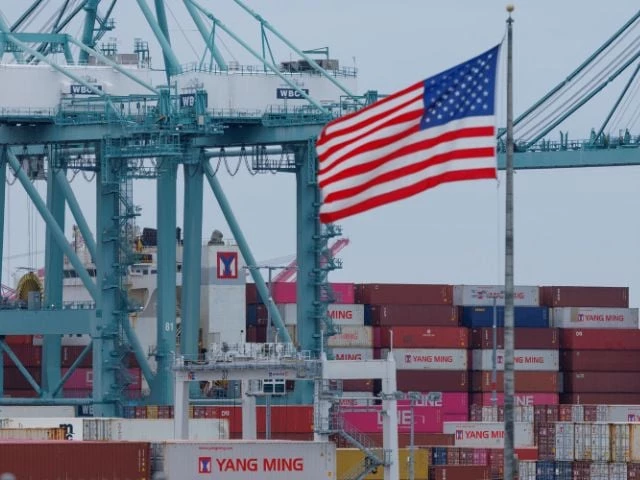Pakistan will face a 19 per cent tariff on its exports to the United States, according to an executive order issued as US President Donald Trump’s tariff deadline ends August 1.
The revised tariff for Pakistan, down from the previous 29pc, was announced a day after the US and Pakistan finalised a trade agreement in Washington.
Yesterday, a new deal between the United States and Pakistan for the joint development of Pakistan’s oil reserves was announced by Donald Trump.
In a post on his social media platform, Truth Social, Trump stated: “We have just concluded a deal with the country of Pakistan, whereby Pakistan and the United States will work together on developing their massive oil reserves.”
As The Express Tribune reported earlier, Field Marshal Asim Munir’s meeting with Trump and the Pakistani negotiators’ proactive approach ahead of the August 1 deadline had initially played a role in securing a better deal. Pakistan’s chief negotiator, Finance Minister Muhammad Aurangzeb, had described it as a “real win-win deal” for both countries, saying it protected Pakistani exports from steeper retaliatory tariffs
Pakistan gained relative advantage over several regional neighbours under the new US tariff regime, with its 19% rate lower than India’s 25%, Bangladesh’s 20%, Iraq’s 35%, Vietnam’s 20%, and Indonesia’s 19%.
Trump imposed an August 1 deadline for dozens of nations to strike trade deals with the US or face tariffs heightened well above the 10% baseline he had already rolled out.
According to the executive order, Trump set rates including a 35% duty on many goods from Canada, 50% for Brazil, 25% for India, 20% for Taiwan and 39% for Switzerland.
The order listed higher import duty rates of 10% to 41% starting in seven days for 69 trading partners as of 12:01 a.m. EDT (0401 GMT) deadline approached.
Some of them had reached tariff-reducing deals; others had no opportunity to negotiate with his administration. Trump included an exception for some goods shipped within the coming week.
Goods from all other countries not listed would be subject to a 10% US import tax. Trump had previously said that rate might be higher.
The administration also teased that more trade deals were in the pipeline as it seeks to close trade deficits and boost domestic factories.
Facing a Friday deadline of his making, the Republican president has tapped emergency powers, pressured foreign leaders, and pressed ahead with trade policies that sparked a market sell-off when they were first announced in April.
This time, markets had a more muted reaction. Stocks and equity futures fell modestly in Friday morning trading in Asia.
Trump’s order said that some trading partners, “despite having engaged in negotiations, have offered terms that, in my judgment, do not sufficiently address imbalances in our trading relationship or have failed to align sufficiently with the United States on economic and national-security matters.”
Other details are still to come, including on the “rules of origin” that will determine what products might face even higher tariffs.
Trump also said “we have made a few deals today that are excellent deals for the country,” and a US official later told reporters that they were still to be announced.
Canada and Mexico
Trump issued a separate order for Canada that raises the rate on Canadian goods subject to fentanyl-related tariffs to 35%, from 25% previously, saying Canada had “failed to cooperate” in curbing illicit narcotics flows into the US.
The higher tariffs on Canadian goods contrasted sharply with Trump’s decision to grant Mexico a 90-day reprieve from higher tariffs of 30% on many goods to provide more time to negotiate a broader trade pact.
Trump complained to reporters earlier that Canada had “been very poorly led.” Canada’s government did not immediately comment but it has previously disputed there being any basis for the tariffs.
The extension for Mexico avoids a 30% tariff on most Mexican non-automotive and non-metal goods compliant with the US-Mexico-Canada Agreement on trade and came after a Thursday morning call between Trump and Mexican President Claudia Sheinbaum.
India discord
Goods from India appeared to be headed for a 25% tariff after talks bogged down over access to India’s agriculture sector, drawing a higher-rate threat from Trump that also included an unspecified penalty for India’s purchases of Russian oil.
Although negotiations with India were continuing, New Delhi vowed to protect the country’s labor-intensive farm sector, and the threat of higher rates from Trump triggered outrage from the opposition party and a slump in the rupee.
Trump’s rollout of higher import taxes on Friday comes amid more evidence they have begun driving up consumer goods prices.
Commerce Department data released Thursday showed prices for home furnishings and durable household equipment jumped 1.3% in June, the biggest gain since March 2022. Recreational goods and vehicles prices shot up 0.9%, the most since February 2024. Prices for clothing and footwear rose 0.4%.

